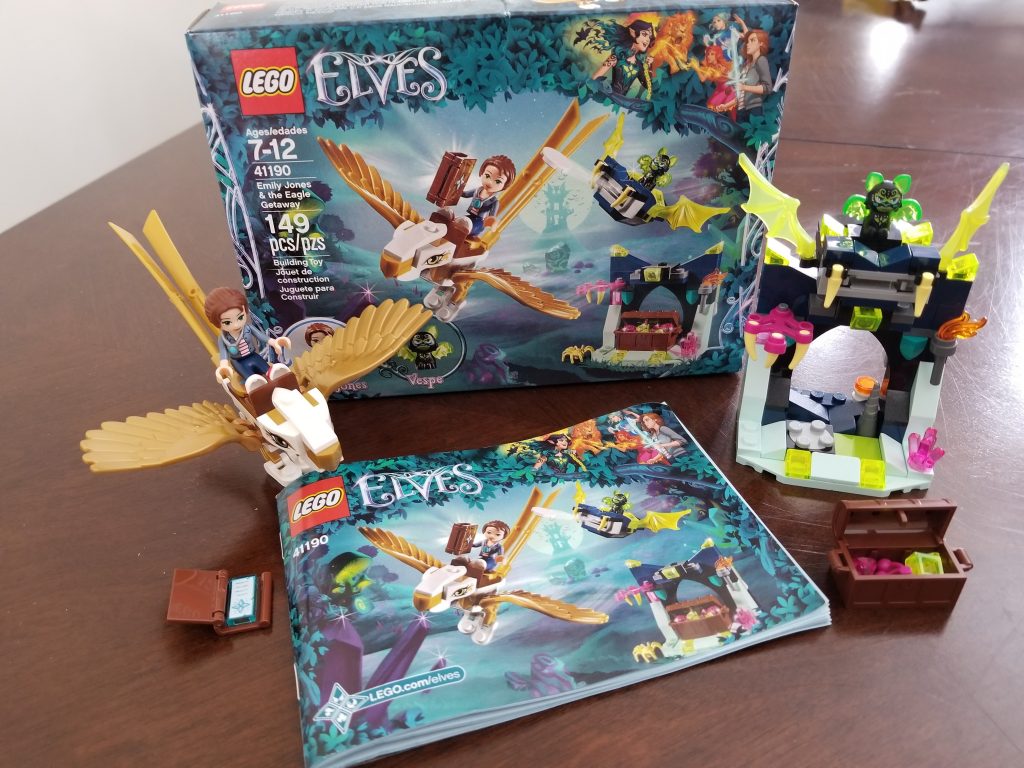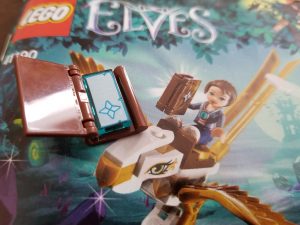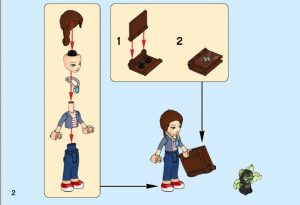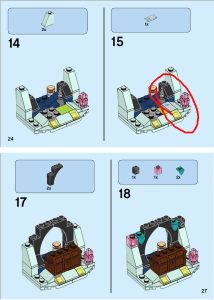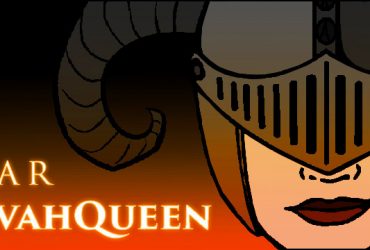Inspired By is a new Behind the Screens subseries in which Ryan talks about something everyday he cames across -be it a book, song, toy, etc- that inspired him as a GM. In today’s installment, he talks about the Emily Jones & the Eagle Getaway set from the Lego Elves line.*
I was surprised that my parents bought my oldest daughter, Scarlett, her first Lego set for her third birthday, and even more surprised that Scarlett was enthusiastic to get it. This weekend, I put the set together with her and got my third surprise: I wanted to GM this set.
This isn’t a toy review, rest assured. While I liked the colours and designs (with minimal pre-made pieces, a pet peeve of Lego purists that I totally get), it was the story told through the play features that caught my attention as a GM. Before looking at the instructions, I picked through some of the parts, admiring the design of the Lego book but finding it strangely empty. There were studs inside, though, so I assumed there was a piece that goes along with it. When I came across a blue piece that was the right size and had a symbol matching the cover of the book, I naturally assumed the pieces went together.
I was therefore confused when I opened the instructions and was not told to put what was obviously the pages of the book into the book.
Where the pages ended up is why this set is inspiring.
In addition to Emily Jones and her Eagle, the set comes with a cave (and a disk-launching bat plane thing that the winged cat in the set rides, but that’s not relevant here). As seen on the cover, there is a treasure chest in the cave. What’s not immediately obvious is that the treasure chest sits on a rotating piece and can be moved without being removed. In its starting position, the page piece is hidden under the treasure chest, in a recess on a piece without studs.
What’s interesting about this set (possibly Lego sets in general, I haven’t bought much Lego in years other than minifigs and a desk calendar) is that there is obviously a story, but it doesn’t spell that story out. It gives you the pieces of the story and leaves you to build it yourself. Maybe that’s Lego cleverly tying their world building in with how their toys are played with, maybe it saves them having to pay copywriters.
Whatever the case, leaving blanks for me to fill in inspired me in the following ways:
- Locks and keys
Puzzles ultimately come down to finding the key for the lock. These don’t have to be literal, however. Imagine finding pageless books with ornate designs on the cover at the start of a dungeon, then coming across pages with the same symbols in the iconography throughout the dungeon. Which symbol indicates which book. Collecting all of a book’s pages turns it into a scroll with the spell necessary to bypass certain obstacles. - Spread the Wealth
The above scenario is a complex variation of a pretty common lock/key puzzle (finding the magic item that grants the ability to bypass an obstacle), but it lets more characters participate in bypassing the obstacle. If it’s a Perception or Knowledge (arcana) to notice the symbols, then the high Perception characters in the party get to participate, plus there’s less weight on the party having someone with a more specialized skill (OK, Knowledge (arcana) is still pretty common, but it’s not Perception common), or on the success of the roll for that one skill. Change it from symbols to each book being written in a different language and Linguistics is added to the mix. Or have a tiny illustration depicting the stages of a famous figure’s journey and you can make it a Knowledge (History) check, giving someone else in the party a chance to participate and giving more information about whoever (in character) made this puzzle. Have a second puzzle on the pages only visible with darkvision. There are countless ways to turn a class feature into the key that unlocks the puzzle. - Escape Rooming
In the idea I outlined, the pages of the book were both a lock and a key. That’s something you find in escape rooms (I love a good escape room), like if there’s a combination lock with four integers, sometimes solving one puzzle gets you all four integers, sometimes you need to solve a puzzle for each integer, only to unlock a new puzzle. Hiding the real treasure under the treasure chest instead of literally anything else drove home how escape roomy this set feels. - Giving Them What They Think They Want
Have you ever (or had a player) open a locked door or get past a tough creature only to find a dead end? Conventional wisdom says it couldn’t possibly be a real dead end, and so you (or they) search harder. Imagine if that dead end had a treasure, but that treasure was a decoy to sate the idea that there must be treasure here. I wouldn’t use this trick for something that the adventure needs to progress (if the players need a knife, I wouldn’t hide the only knife in the dungeon under 10 000 spoons), I would save this trick for the kind of treasure that needs a special kind of hiding place: a phylactery, kryptonite, etc. An optional shortcut that the players need to earn. - Filling in the Blanks
The difference between a trap and a puzzle (at least in Pathfinder) is that one is tightly tied to mechanics, the other takes thought. I am in the “if players don’t need to do backflips at the table to pass acrobatics checks, they shouldn’t have to be charming at the table to pass diplomacy checks” camp, but I do admit that it’s rewarding as a player to use my own wit to solve a puzzle or figure out a plot. In the case of this Lego set, had they not added the same symbol to the book and the pages, I wouldn’t have made the connection. Because they did, the pages wasn’t just a piece of Lego in a strange place, it was a clue to mystery, and I felt pretty good solving it. - Fitting the Pieces Together
The designers of this set could have just had the treasure chest sitting on some studs that when removed reveal the pages. Instead, they deliberately included a piece that can be pivoted. Furthermore, the page could have been on studs to hold it in place. Again, they deliberately made a choice to include a piece without studs to put the pages on. Why this is important is that the Emily Clarke minifig can turn the treasure chest and pick up the pages. As a GM, it’s important to remember to build your encounters with both the players in mind and the characters. Don’t just write the DC of the perception check required to find that there is more to the chest than first appears. Understand what the characters find when the player makes the Perception check. Don’t just say they find a page, have them find the hinges and let the characters turn the chest and find the pages. Little moments that flesh out the world are opportunities for immersion.
Inspiration is all around us. I put together a Lego set that made me want to GM a dungeon with a layered mystery involving empty books and secret pages. Who knows where we as GMs will find inspiration next.
*Lego was criticized for separating its lines into genders. At the time, they were most heavily criticized because the boys lines were about fulfilling power fantasies and the one girls line was about running restaurants and hanging out with friends. Since then, they’ve branched the girls line out to include their Disney Princess and DC Super Hero Girls licenses and this fantasy line, ie a better variety of reasons to buy-in. It may still be mystifying that Lego marketing felt the need for two separate minifig body types, but if that’s what it takes to get mainstream pastel coloured pieces and to get my parents to buy their granddaughter a Lego set, it’s a step in the right direction.


